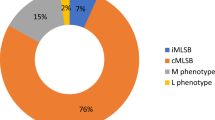Summary
153 strains of Klebsiella pneumoniae from 16 microbiological institutes in Germany, Austria and Switzerland were typed biochemically and serologically; their sensitivities to cefoxitin, cefotaxime, ceftazidime, ceftriaxone, lamoxactam, thienamycin and gentamicin were determined. The strains could be classified into seven biotypes and 43 K-antigen types. The distribution of the K-antigen types was random, and spread over the whole spectrum of the 72 possibilities. Regional variations were not observed. 4.6% of the isolates were resistant to cefoxitin and 23% were moderately sensitive. 98% of theseKlebsiella strains were sensitive to the new cephalosporins which were also effective against gentamicin-resistant isolates accounting for 12% of all isolates studied. Cefoxitin was only slightly active against such strains. The effect of a standard concentration of each agent on bacterial cultures during their growth phase was measured in the Jouan biophotometer. The β-lactamase-stable cephalosporins had a permanent bactericidal effect on the enzyme-producing reference strain, although the latent period varied considerably in some cases. Piperacillin and cefoperazone were not bactericidal in this test.
Zusammenfassung
Insgesamt 153Klebsiella pneumoniae-Stämme von 16 mikrobiologischen Instituten in Deutschland, Österreich und der Schweiz wurden biochemisch und serologisch typisiert und deren Empfindlichkeit gegenüber Cefoxitin, Cefotaxim, Ceftazidim, Ceftriaxon, Lamoxactam, Thienamycin und Gentamicin bestimmt. Die Stämme konnten in sieben Biotypen und 43 K-Antigen-Serotypen differenziert werden. Die Verteilung der K-Antigen-Typen war zufällig und betraf das ganze Spektrum der 72 Möglichkeiten. Regionale Unterschiede wurden nicht beobachtet. Insgesamt 4,6% der Isolate waren resistent gegenüber Cefoxitin, 23% waren mäßig empfindlich. Gegenüber den neuen Cephalosporinen waren 98% der Klebsiella-Stämme empfindlich, und gleichermaßen die Gentamicin-resistenten Isolate (12%). Bei diesen zeigte Cefoxitin nur eine schwache Aktivität. Die Wirkung einer äquivalenten Konzentration jedes Antibiotikums gegenüber sich vermehrenden Bakterienkulturen wurde in einem Jouan Biophotometer analysiert. Die Beta-Laktamase-stabilen Cephalosporine führten zu einem permanenten bakteriziden Effekt gegenüber dem Beta-Laktamase-produzierenden Referenzstamm; sie unterschieden sich zum Teil erheblich hinsichtlich ihrer Latenzzeit. Piperacillin und Cefoperazon dagegen führten unter diesen Versuchsbedingungen zu keiner Bakterizidie.
Similar content being viewed by others
Literature
Daschner, F., Langmaack, H., André, H., Beuchel, U., Gulatz, H., Saal, E., Scherer-Klein, E., Schleipen, W., Weber, L. Krankenhausinfektionen in einem Universitätsklinikum. Prospektive Analyse von 39.802 Patienten. Dtsch. Med. Wschr. 106 (1981) 101–105.
Ullmann, U.: Anaerobierinfektionen in der Chirurgie. In:Voigt, J. (Hrsg.): Gasbrand. Springer, Berlin, Heidelberg, New York, im Druck.
Buffenmeyer, C. L., Rychek, R. R., Yee, R. B. Bacteriocin (Klebocin) sensitivity typing of Klebsiella. J. Clin. Microbiol. 4 (1976) 239–244.
Bauernfeind, A., Petermüller, C. H., Schneider, R. Bacteriocins as tools in analysis of nosocomialKlebsiella pneumoniae infections. J. Clin. Microbiol. 14 (1981) 15–19.
Kauffman, F. On the serology of theKlebsiella group. Acta Pathol. Microbiol. Scand. 26 (1949) 381–406.
Ørskov, I. Serological investigations in theKlebsiella group. 1. New capsule types. Acta Pathol. Microbiol. Scand. 26 (1955 a) 449–453.
Casewell, M. W. Experiences in the use of commercial antisera for the capsular typing ofKlebsiella species. J. Clin. Pathol. 25 (1972) 734–737.
Ullmann, U. In-vitro-Untersuchungen über die Wirkung der Kombination von Gentamicin und Beta-Lactamantibiotika aufPseudomonas aeruginosa. Immun. Infekt. 3 (1975) 79–84.
Link, C. Retrospektive Studie überKlebsiella pneumoniae-Stämme in zwei Tübinger Universitätskliniken. Inauguraldissertation, Tübingen 1981.
Blanchette, E. A., Rubin, S. J. Seroepidemiology of clinical isolates ofKlebsiella in Connecticut. J. Clin. Microbiol. 11 (1980) 474–478.
Casewell, M. W., Phillips, I. Epidemiological patterns ofKlebsiella colonization and infection in an intensive care ward. J. Hyg. (Camb.) 80 (1978) 295–300.
Curie, K., Speller, D. C. E., Simpson, R. H., Stephens, M., Cooke, D. I. A hospital epidemic caused by a gentamicin-resistantKlebsiella aerogenes, J. Hyg. (Camb.) 80 (1978) 115–123.
Fu, K. P., Neu, H. C. Piperacillin, a new penicillin against many bacteria resistant to other penicillins. Antimicrob. Agents Chemother. 13 (1978) 358–367.
Author information
Authors and Affiliations
Rights and permissions
About this article
Cite this article
Ullmann, U. The distribution of Klebsiella pneumoniae serotypes from different sources and their sensitivity to cephalosporins. Infection 11 (Suppl 1), S28–S31 (1983). https://doi.org/10.1007/BF01641102
Issue Date:
DOI: https://doi.org/10.1007/BF01641102




